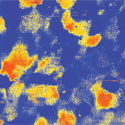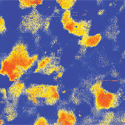The ripple effect?
Graphene is considered a two-dimensional form of carbon but it is never atomically flat. Nanometer-scale deformations or ripples exist in graphene regardless of whether it is suspended or placed on a substrate such as . These ripples are responsible for the unusual metallic behavior of graphene, even for very low concentrations of carriers where electron localization may be expected. In addition to intrinsic ripples, graphene is also susceptible to adsorbed impurities and defects.
In an article appearing in Physical Review B, Aparna Deshpande and collaborators from the University of Arizona, Tucson, and the University of California, Riverside, have spatially mapped the local density of electronic states in graphene on an substrate to better understand the different scattering mechanisms that govern electronic transport. With scanning tunneling spectroscopy, they achieve an unprecedented spatial resolution of the local density of states, which they obtain by measuring the differential conductance as a function of position. The presence of charge inhomogeneity results in a shift in the Dirac point—where the conduction band meets the valence band—to finite bias voltage.
The graphene ripples have a height variation of about over an area of and their lateral extent follows the corrugation of the substrate. If intrinsic ripples were the only factor determining electron scattering, then highly curved regions would appear to be electron-doped and flat regions hole-doped. However, electron and hole puddles do not correlate with the curvature measured in topographic images. Instead, the Dirac point shift is consistent with long-range scattering from random charged impurities at the graphene-substrate interface. These impurities also contribute to graphene’s finite minimum conductivity that exists even at zero voltage bias. – Sarma Kancharla





